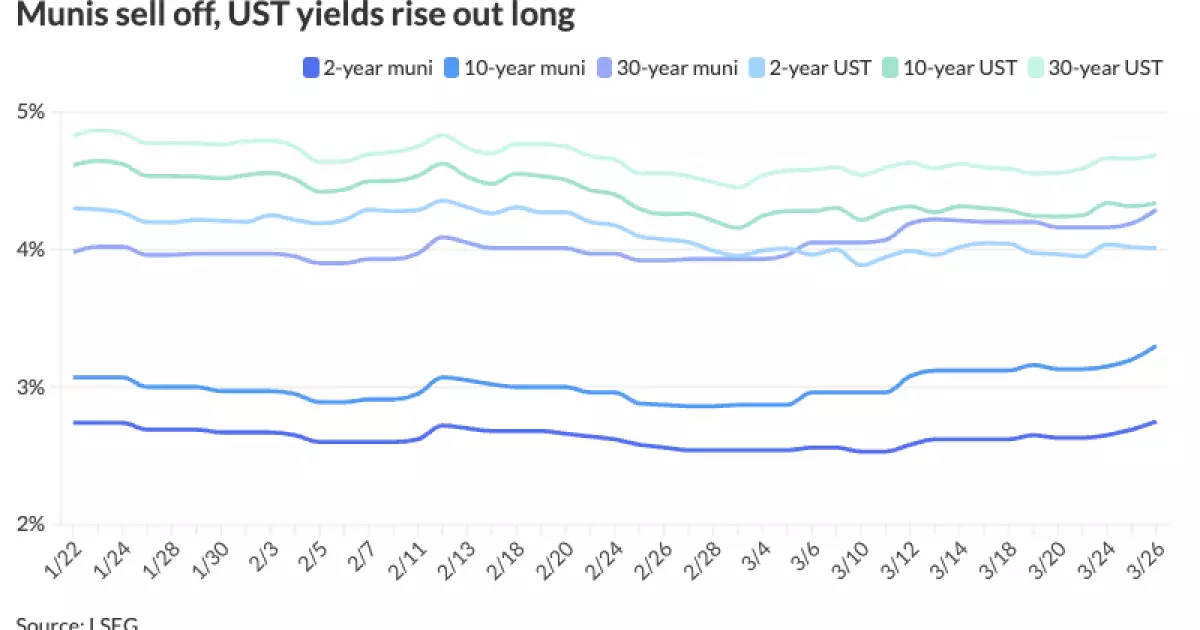In a rather unexpected turn, the municipal bond market experienced a notable sell-off on a Wednesday marked by double-digit yield cuts—this being the second occurrence within the month. While it may seem like all is well in the world of finance from the surface, a deeper dive reveals a turbulent environment for municipal debt. On that same day, U.S. Treasury yields rose—an unsettling sign that could translate into increased borrowing costs for municipalities seeking to finance essential projects. It’s a classic case of the market trying to hold onto its illusions while reality looms large, and the ramifications are felt most acutely by the investors who may have thought they were safe.
The adjustment in yields paints a complex picture. Municipal yields faced cuts ranging from two to 12 basis points, while Treasury yields climbed by up to three basis points—an indication of the challenges inherent in balancing supply and demand in a tightening economic environment. As investors grapple with these seemingly paradoxical trends, the ratios of municipal to U.S. Treasury (UST) bonds remain indicative of market sentiment. For example, the two-year muni-to-UST ratio stood at 69%, suggesting that while short-term prospects may look positive, the credit landscape remains muddied.
Fluctuating Inflows and Bearish Sentiments
The Investment Company Institute reported a modest weekly inflow of $19 million, starkly contrasting against a previous influx of $376 million. This raises a critical question: what has changed in just one week? Could it be that investors are starting to eye municipal bonds with greater skepticism? The markets need to be carefully navigated, particularly amid whispers of outflows, like the staggering $216.4 million reported by LSEG for the same timeframe.
The nature of inflows and outflows is nothing short of a symptom of broader market conditions. Analyzing the opportunities and threats, experts like James Pruskowski of 16Rock Asset Management highlight the “aggressive selling” we are seeing as the quarter-end approaches. The tension in the market signals not just an adjustment but possibly a shift in investor confidence. With fears of liquidity issues cropping up, the so-called credit spreads seem to be widening—a move that implies greater risk in the market, particularly for lower-rated securities.
The Current Terrain: Risk-Off and Cautious
According to industry insiders, such as Ron Banaszek from Blaylock Van, the sentiment is decidedly “risk-off.” This notion of caution permeates both secondary market traders and long-term investors alike—potentially warning of an impending reevaluation period. Despite caution being the prevailing mood, one must consider if the sentiment aligns with reality or merely reflects apprehensions that could create a self-fulfilling prophecy.
The trends indicate a propensity for a broader market recalibration driven by macroeconomic risks and policy changes, including tariffs and evolving tax proposals. The mention of cryptocurrencies like DOGE may seem tangential, yet it points toward unpredictable elements that could further derail investor confidence, especially in the public finance domain.
Liquidity Challenges and Market Dynamics
Liquidity, or the lack thereof, emerges as a critical theme in this shifting landscape. As seasoned players retreat into defensive strategies, the scarcity of available capital creates an obstacle for bonds that typically draw attention. Notably, names that are usually market darlings are struggling to attract investors willing to gamble on their yields in this increasingly cautious climate.
The enormity of the situation is underscored by the fact that there is a palpable need for a catalyst to reinvigorate the market, as indicated by Pruskowski. Investors are clearly looking for some signal or “hook” to guide their decisions amid employment numbers and considering the most recent data points.
The Dichotomy of Opportunity Amidst Volatility
At the heart of all the chaos lies a ray of opportunity. Despite the turbulent re-pricing of munis, the fluctuations experienced aren’t entirely grim. For astute investors, this volatility often leads to attractive valuations—especially on a relative basis. In periods of heightened uncertainty, the market can overshoot itself, thereby creating openings for those willing to take calculated risks.
Prudent investors may find themselves weighing potential returns against prospective risks, particularly as they consider upcoming primary market deals like those being pursued by institutions such as the Board of Regents of the Texas A&M University System. With careful positioning and a long-term perspective, opportunities may be just waiting to be seized.
It is evident that while the municipal bond market faces significant challenges, it simultaneously stands poised at the edge of change. The big question now is whether investors will have the foresight and patience to navigate this treacherous terrain. The financial landscapes are shifting, and while the outlook is complicated, for those equipped with a resilient strategy, a wealth of opportunity lies beneath the surface.

